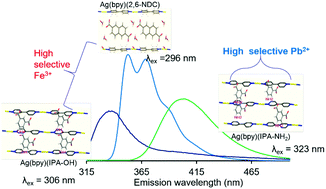Unraveling the highly selective nature of silver-based metal–organic complexes for the detection of metal ions: the synergistic effect of dicarboxylic acid linkers†
Abstract
Photoluminescent metal–organic complexes (PLMOCs) have become attractive materials for highly selective metal ion detection because of their unique physical and chemical properties. However, the fundamental understanding of the characteristics of PLMOCs and metal ion sensing is still lacking. We report the synthesis of a series of Ag(bpy)(DA) PLMOCs (DA = dicarboxylic acids) and unravel key factors of the Ag-based PLMOCs regarding sensitivity in metal ion detection. The DA linkers with strong electron-donating groups (–NH2 and –OH) resulted in a red-shift in the PL emission of the Ag-based PLMOCs. Ag(bpy)(DA), displaying emission peaks in the UV region, showed higher sensitivity for Fe3+ compared to Ag-based PLMOCs with the emission peaks located in the vis region. Moreover, Ag(bpy)(DA) comprised of DA linkers with an amine group could exhibit sensitive detection toward Pb2+.



 Please wait while we load your content...
Please wait while we load your content...